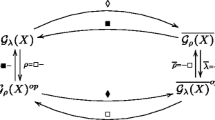Abstract
The paper provides an alternative interpretation of ‘pair points’, discussed in [3]. Pair points are seen as points viewed from two different ‘perspectives’ and the latter are explicated in terms of two independent valuations. The interpretation is developed into a semantics using pairs of Kripke models (‘pair models’). It is demonstrated that, if certain conditions are fulfilled, pair models are validity-preserving copies of positive substructural models. This yields a general soundness and completeness result for a variety of (positive) substructural logics with respect to multimodal Kripke frames with binary accessibility relations. In addition, an epistemic interpretation of pair models is provided.
Access this chapter
Tax calculation will be finalised at checkout
Purchases are for personal use only
Similar content being viewed by others
Notes
- 1.
- 2.
- 3.
A familiar example of similar ‘inter-model’ truth conditions are the conditions for public announcement formulas \([A]B\) in public announcement logic. See [11].
- 4.
Needless to point out, the interpretation is rather close to the Ramsey Test.
References
Barwise, J., & Perry, J. (1983). Situations and attitudes. Cambridge: MIT Press.
Beall J. C. (2009) Spandrels of truth. Oxford: Oxford University Press.
Beall, J. C., Brady, R., Dunn, J. M., Hazen, A., Mares, E., Meyer, R., et al. (2012). On the ternary relation and conditionality. Journal of Philosophical Logic, 41(3), 595–612.
Blackburn, P., Rijke, M., & Venema, Y. (2001). Modal logic. Cambridge: Cambridge University Press.
Dunn, J. M. (1976). A Kripke-style semantics for R-mingle using a binary accessibility relation. Studia Logica, 35(2), 163–172.
Dunn, J. M. (1987). Incompleteness of the bibinary semantics for R. The Bulletin of the Section of Logic, 16(3), 107–109.
Kurtonina, N. (1998). Categorial inference and modal logic. Journal of Logic, Language and Information, 7, 399–411.
Mares, E. (2004). Relevant logic: A philosophical interpretation. Cambridge: Cambridge University Press.
Meyer, R. K., & Routley, R. (1973). Classical relevant logics II. Studia Logica, 33(2), 183–194.
Restall, G. (2000). An introduction to substructural logics. London and New York: Routledge.
van Ditmarsch, H., van der Hoek, W., & Kooi, B. (2008). Dynamic epistemic logic. Dordrecht: Springer.
Vasyukov, V. L. (1986). The bibinary semantics for R and Ł\(_{\aleph _0}\). The Bulletin of the Section of Logic, 15(3), 109–114.
Vasyukov, V. L. (1994). From ternary to tetrary? The Bulletin of the Section of Logic, 23(4), 163–167.
Acknowledgments
This work was carried out at the Department of Logic and Methodology of Sciences, Comenius University, as a part of the research project ‘Semantic models, their explanatory power and applications’, supported by the grant VEGA 1/0046/11. I wish to express my gratitude to the audience at Trends in Logic XI for helpful discussion and to two anonymous referees for enabling me to improve the paper by providing a number of constructive suggestions. Thanks are also due to Jc Beall, Mike Dunn, Ed Mares and Graham Priest: their encouragement is much appreciated.
Author information
Authors and Affiliations
Corresponding author
Editor information
Editors and Affiliations
Rights and permissions
Copyright information
© 2014 Springer International Publishing Switzerland
About this chapter
Cite this chapter
Sedlár, I. (2014). Inter-Model Connectives and Substructural Logics. In: Ciuni, R., Wansing, H., Willkommen, C. (eds) Recent Trends in Philosophical Logic. Trends in Logic, vol 41. Springer, Cham. https://doi.org/10.1007/978-3-319-06080-4_14
Download citation
DOI: https://doi.org/10.1007/978-3-319-06080-4_14
Published:
Publisher Name: Springer, Cham
Print ISBN: 978-3-319-06079-8
Online ISBN: 978-3-319-06080-4
eBook Packages: Mathematics and StatisticsMathematics and Statistics (R0)




